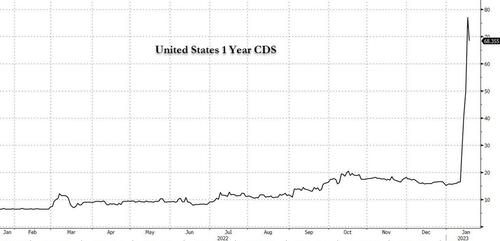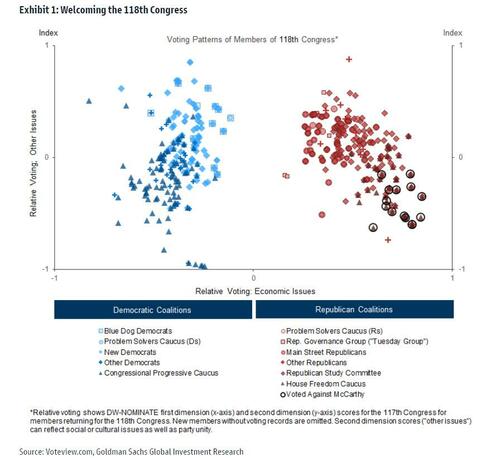US Treasury Hits Debt Ceiling, Begins Using “Extraordinary Measures”, Yellen Tells Congress
One week ago we correct predicted that the Treasury would hit its debt ceiling today, and as expected, in a letter to House speaker Kevin McCarthy, Yellen today wrote that “beginning on January 19, the outstanding debt of the United States was projected to reach the statutory limit” and that the “Treasury began using extraordinary measures” today. Some more details from the letter:
Dear Mr. Speaker:
I write to keep you apprised of actions the Treasury Department is taking in regard to the debt limit. In my letter of January 13, 2023, I noted that Public Law 117-73 increased the statutory debt limit to a level of $31.381 trillion, and informed you that beginning on January 19, the outstanding debt of the United States was projected to reach the statutory limit. This letter serves to notify you, pursuant to 5 U.S.C. § 8348(l)(2), of the extraordinary measures Treasury began using today.
First, I have determined that, by reason of the statutory debt limit, I will be unable to fully invest the portion of the Civil Service Retirement and Disability Fund (CSRDF) not immediately required to pay beneficiaries, and that a “debt issuance suspension period” will begin on Thursday, January 19, 2023, and last through Monday, June 5, 2023. My predecessors have declared debt issuance suspension periods under similar circumstances. With these determinations, the Treasury Department will suspend additional investments of amounts credited to, and redeem a portion of the investments held by, the CSRDF, as expressly authorized by law.
In addition, because the Postal Accountability and Enhancement Act of 2006 provides that investments in the Postal Service Retiree Health Benefits Fund (PSRHBF) shall be made in the same manner as investments for the CSRDF, Treasury will suspend additional investments of amounts credited to the PSRHBF. By law, the CSRDF and the PSRHBF will be made whole once the debt limit is increased or suspended. Federal retirees and employees will be unaffected by these actions.
As I stated in my January 13 letter, the period of time that extraordinary measures may last is subject to considerable uncertainty, including the challenges of forecasting the payments and receipts of the U.S. Government months into the future. I respectfully urge Congress to act promptly to protect the full faith and credit of the United States.
Sincerely,
Janet L. Yellen
Here are the two highlights: the “debt issuance suspension period” will begin on Thursday, January 19, 2023, and last through Monday, June 5, 2023, which means that there will be no net debt issuance until at least June and more likely Sept or Oct; instead there will be a shift between various assets and liabilities, with the Treasury cash set to be drained rapidly over the coming months to offset the lack of net issuance.
Just as importantly Yellen noted that “the period of time that extraordinary measures may last is subject to considerable uncertainty, including the challenges of forecasting the payments and receipts of the U.S. Government months into the future.” Here, we will remind reader that according to Goldman, extraordinary measures will likely last until early September, or potentially until October if factoring in the burst of corporate tax payments.

After that a US default becomes inevitable and is why a deal will be reached in the 11th hour as usual.
However, it is what happens until then that is critical and as we discussed over the weekend, the coming drain in the Treasury cash balance, also known as the Treasury General Account, will crash and burn the Fed’s QT plans as any liquidity drain via TSY and MBS runoff will be more than offset by the rapid TGA drain in the coming months. As a reminder, as of this week, the Treasury has some $399BN in cash…

… And as we explained earlier this week, the rapid TGA decline means Fed reserves – which Powell has been hoping will slump and depress stocks – will instead remain elevated until at least September, and likely beyond since it will be Overnight Repo that is drained rapidly in the last months of the year to replenish the Treasury cash balance once the next debt ceiling deal is struck.

Finally, while everyone knows that the debt ceiling fiasco is just theater, this year the market is taking it much more seriously, with 1Y US CDS exploding higher…

… perhaps because as Goldman warned with Congress more polarized than ever and speaker McCarthy beholden to a handful of conservative republicans…

… the odds of something going very wrong in the last minute are the highest they have been since 2011 when S&P downgraded the US AAA rating and sent risk assets tumbling. Needless to say a full US default would not be bullish.
For much more, please see “How The Coming Debt Ceiling Debacle Blew Up The Fed’s QT, And What Happens Next.”
Loading…
[ad_2]
Source link


